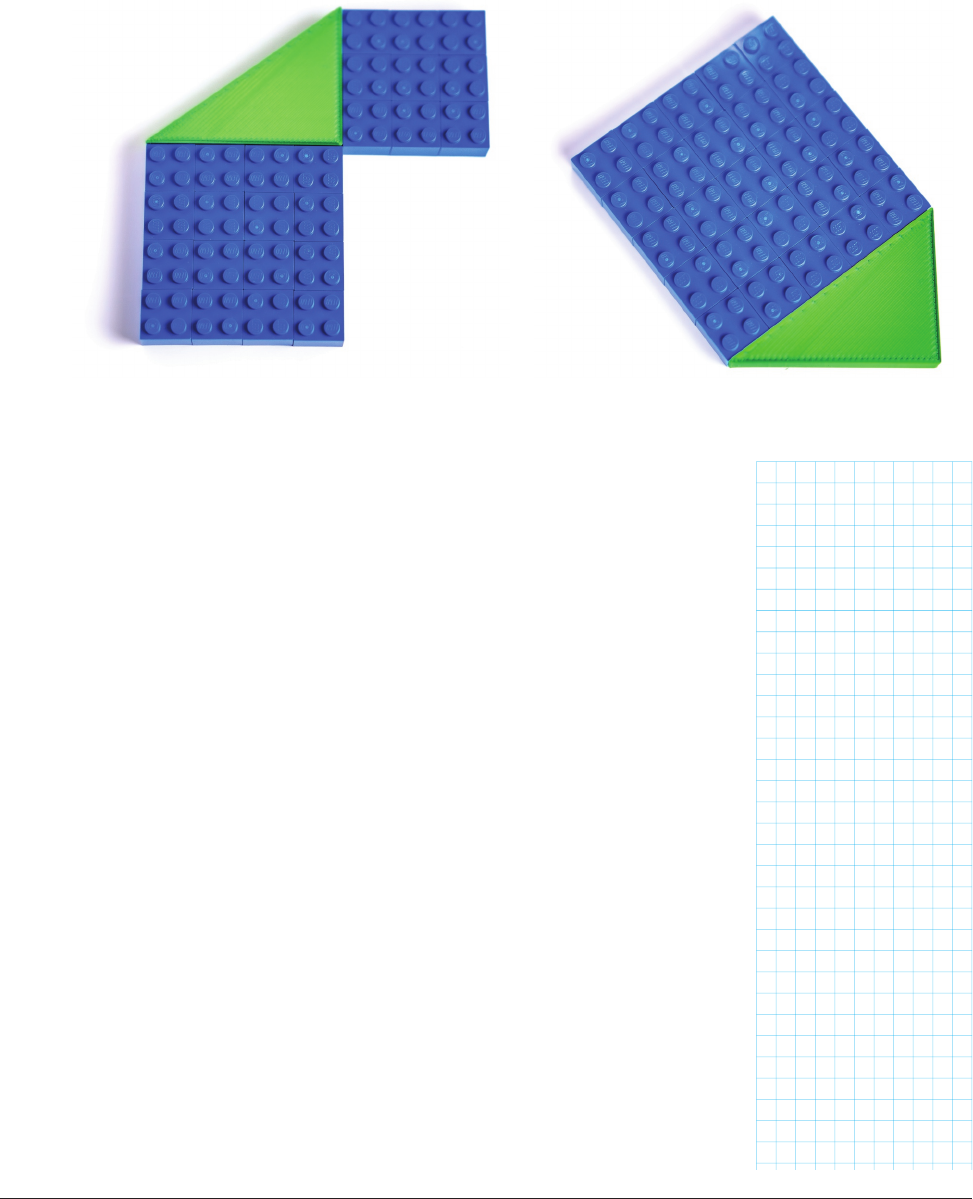
6
CHAPTER 6
PYTHAGORAS
AND A LITTLE
TRIGONOMETRY
Make: Geometry 103
102 Chapter 6: Pythagoras and a Little Trigonometry
Geometry_Chapter10_v15.indd 102Geometry_Chapter10_v15.indd 102 6/23/2021 9:09:41 AM6/23/2021 9:09:41 AM

You may be detecting that a lot of what we have
talked about has its roots in Greece somewhat
more than 2000 years ago. We’ll keep that
theme in this chapter, starting with a theorem
by Pythagoras, a Greek philosopher who lived
around 2500 years ago and is known for advo-
cating common living and sharing of goods as
well as for mathematical ideas. The record is a
little murky that long ago, but many historians
think he was the one to come up with a theorem
that bears his name, about how the lengths of
the sides of a right triangle relate to each other.
It seems a little magic, or a coincidence, but we
will prove it, and use it, in the early part of this
chapter.
Then, armed with new ideas about right tri-
angles, we will meet the Greek astronomer
Hipparchus, who lived about 2100 years ago and
who is regarded as the father of trigonometry.
Even though people talk about the difference
between a geometry class and a trigonometry
class, in the end it is all math, providing you with
tools that you can use to solve problems. In that
spirit, this chapter gives you a bit of trigonometry
(trig, to its friends) that we’ll use in the chapters
and applications that follow.
We hope you are also feeling how it must have
been for these long-ago mathematicians when
they realized they were understanding some-
thing for the first time ever. We love how it
feels when another concept clicks together in
our heads; mathematicians often use the word
“elegant.” To be a little more pragmatic, think of it
as another rung to snap on a ladder you’re build-
ing while you climb it - be sure each piece is firmly
attached before you rush upwards!
3D Printable Models Used in
this Chapter
See Chapter 2 for directions on where and how to
download these models.
ExtrudedTriangle.scad
Just two lines long, this model draws a triangle
from any three points and extrudes it to the
desired thickness.
theodorus.scad
Creates a Spiral of Theodorus
hypotenuse.scad
Creates a “slide rule” triangle model for measur-
ing sine and cosine.
Other supplies for this chapter
• 25 2x2 LEGO bricks
• A few pieces of construction or similar heavy
paper
• Regular paper to sketch on
• A calculator that can find sine, cosine, and
tangent
• Ruler
Make: Geometry 103
Geometry_Chapter10_v15.indd 103Geometry_Chapter10_v15.indd 103 6/23/2021 9:09:41 AM6/23/2021 9:09:41 AM

PYTHAGOREAN
THEOREM
About 2500 years ago, Pythagoras figured out
that if you have a triangle that has one right
angle, there is a relationship between the
longest side and the two shorter ones. Specif-
ically, if we add the squares of the two shorter
sides, we get the square of the longest side (the
hypotenuse). As an equation, if the two shorter
sides are of length a and b and the longest is of
length c, the Pythagorean Theorem says:
a
2
+
b
2
=
c
2
For example, if the hypotenuse of a triangle is
30mm long, then 30mm squared, or 900 sq mm,
is the sum of the squares of the sides. Let’s say
that we want the other two sides to be the same
length as each other(a = b). We know that
a
2
+
b
2
=
c
2
Since a = b, then (2 * a
2
) =
c
2
2 * a
2
=
900
a
2
=
900/2
now take the square root of a
2
a = b = 21.2mm
PYTHAGORAS’ LEGO
We can demonstrate this with LEGO bricks and a 3D-printed triangle. A 2 * 2 LEGO brick is 16mm *
16mm by just shy of 10mm deep. If we have four of them on one side (64mm), and three on the other
(48mm), that means that the square of the longest side should be 3 squared plus 4 squared, or 9 + 16 =
25 (Figure 6-1). The hypotenuse of the triangle should fit 5 bricks exactly (Figure 6-2).
You can use the model ExtrudedTriangle.SCAD to generate a triangle with one side 64mm long and
the other 48mm long, at right angles to each other. We will want it to be 10mm thick. To do that, update
ExtrudedTriangle.scad as follows. Or just use these two lines as your model; see Chapter 2 to learn how
to make a new OpenSCAD model.
thickness = 10;
Squares and Square Roots
If symbols like a
2
are new to you, they may look
scary but are pretty easy to understand. What
a
2
means is “take the number a and multiply it
by itself.” Or, in other words, a
2
is a * a. Then if we
want to multiply by a one more time, we write a
3
=
a * a * a, and so on.
We can go the other direction, too. Suppose we
know that a
2
= 2. That means that something
times itself equals 2. Figuring this out is called
taking a square root, and its symbol looks like
this:
√2
You probably have a button on your calculator
that says “
√ ”, and if you want to use Google to get
the square root of 2, you would type sqrt(2).
Make: Geometry 105
104 Chapter 6: Pythagoras and a Little Trigonometry
Geometry_Chapter10_v15.indd 104Geometry_Chapter10_v15.indd 104 6/23/2021 9:09:41 AM6/23/2021 9:09:41 AM

linear_extrude(thickness) polygon([[0, 0], [64, 0], [64, 48]]);
Take that triangle and 25 2 * 2 LEGO bricks. Make a square of 9 of the bricks
and a square of 16 of them. These will align with the two short sides. Now
rearrange these bricks into a 5 by 5 square, which will line up with the
hypotenuse.
If you use a different-size counting piece, you will need to adjust the triangle
you create. There are a few “Pythagorean Triples” that come out to nice round
numbers like this (the next one is 5, 12, 13), and there are long lists available if
you search on that phrase.
You can use the Pythagorean theorem any time it is easy to measure two dis-
tances or lengths in directions perpendicular to each other, and you want to
know the shortest distance between the farthest-apart points of the triangle.
If you started at the left end of the hypotenuse and traveled right and then
up to get to the right end, your path would be longer than if you just traveled
along the hypotenuse.
MAKING A SPIRAL OF THEODORUS
What happens if we construct a series of right triangles in succession?
About 2500 years ago, Theodorus of Cyrene came up with a way to make
a physical calculator, of sorts, for square roots based on the Pythagorean
theorem. Theodorus probably lived a bit later than Pythagoras, but his life
is less well-documented. His construct is called the Spiral of Theodorus (or,
FIGURE 61: The sides of the triangle line up with 3 and 4
bricks each.
FIGURE 62: The hypotenuse of the triangle lines up with 5
bricks.
Make: Geometry 105
Geometry_Chapter10_v15.indd 105Geometry_Chapter10_v15.indd 105 6/23/2021 9:09:42 AM6/23/2021 9:09:42 AM

sometimes, the Pythagorean Spiral, but we’ll give the lesser-known mathe-
matician his due here).
First, let’s make a Spiral of Theodorus with just a ruler and paper, so we can
see where things came from. First, draw a right triangle with the two sides
equal to 1cm in length. (Units don’t matter, since everything is a ratio later
on, but it might help to try this exercise on graph paper.) When you draw in its
hypotenuse, the Pythagorean Theorem says its length will be the square root
of 1
2
+ 1
2
= 1 + 1, or √
2
(Figure 6-3).
If we wanted to get √
2
without a calculator, we could just measure that side
in centimeters (if our other sides were both 1cm). But Theodotus had a bigger
idea. What if you kept going, and added another triangle with its sides equal
to 1 and √
2
? Then the hypotenuse of THAT triangle would be √
3
(Figure 6-4).
FIGURE 63: First triangle for Spiral of Theodorus.
FIGURE 65: 3D print of first three triangles for Spiral of
Theodorus.
FIGURE 64: First two triangles for Spiral of Theodorus.
FIGURE 66: 3D print of first 17 triangles for Spiral of
Theodorus.
Make: Geometry 107
106 Chapter 6: Pythagoras and a Little Trigonometry
Geometry_Chapter10_v15.indd 106Geometry_Chapter10_v15.indd 106 6/23/2021 9:09:43 AM6/23/2021 9:09:43 AM
..................Content has been hidden....................
You can't read the all page of ebook, please click here login for view all page.
